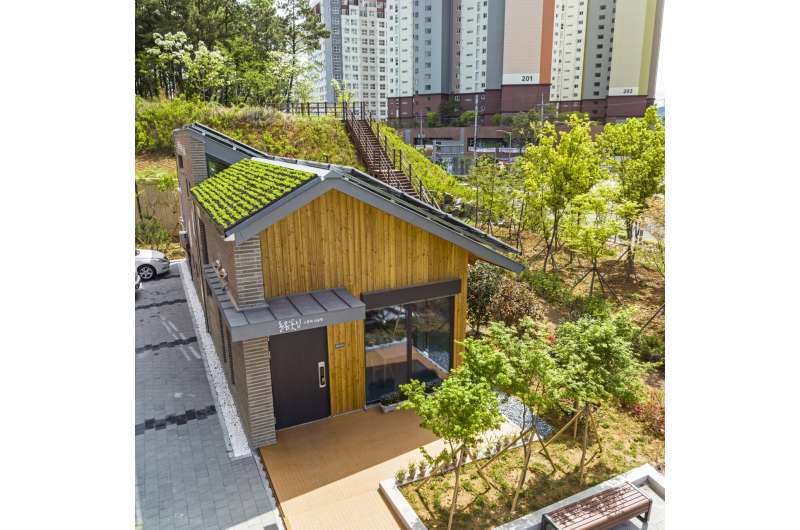This article has been reviewed according to Science X's editorial process and policies. Editors have highlighted the following attributes while ensuring the content's credibility:
fact-checked
proofread
A green path to net zero carbon building

The Korea Institute of Civil Engineering and Building Technology (KICT) has mad progress in the field of ecological building technology with the development of a new "Net Zero Carbon Building (NZCB) system." This innovative system, designed to minimize both operating carbon and embodied carbon, holds the key to significantly reducing carbon emissions in the construction industry.
Embodied carbon, which encompasses the carbon emissions generated during the production, transportation, construction and disposal of building materials, is a critical factor in addressing carbon neutrality. In addition to the well-known operating carbon emitted during the buildings operational phase, the reduction of embodied carbon from the material production stage is essential. According to Global ABCs 2019 report, operating and embedded carbon contribute to approximately 39% of global greenhouse gas emissions.
Traditionally, the construction sector has primarily focused on optimizing operational energy, such as lighting and heating, to mitigate carbon emissions.
However, minimizing embodied carbon is now recognized as a fundamental requirement for achieving carbon-neutral building. In response to this challenge, the Ecological Building Research Group at KICT (Dr. Hyeon Soo Kim, Dr. Soo-Young, Moon), has successfully developed a new NZCB system capable of simultaneously reducing both operational and embodied carbon. This system was recently tested in Jinju City, Korea.
The research team, led by Dr. Hyeon Soo Kim, incorporated thirteen major technologies into the NZCB system. Among these technologies, the most noteworthy is the adoption of the eco-friendly cement (High Sulfated Calcium Silicate Cement, HSCSC), which has the remarkable capability of reducing CO2 emissions by more than 90% while minimizing environmental impact.
Ordinary Portland Cement (OPC), a commonly used concrete material, emits 1.2 kg of carbon per kg during production. In contrast, HSCSC emits only 0.07 kg of carbon per kg, resulting in a reduction of 1,130 kg of carbon emissions per ton compared to OPC.
Another noteworthy advancement is the development of CXP (Cellulose X-linked Polymer), an eco-friendly thermoplastic composed solely of wood and natural resin. The research team pioneered the creation and application of CXP-based deck materials for exterior use, the first of its kind worldwide.
To evaluate the efficacy of the NZCB system, the research team conducted monitoring of operational and embodied carbon reduction at the Gaho community center in Jinju City, Korea. A comparative analysis was carried out, comparing the environmental performance and embodied carbon emissions of the community center as a NZCB with that of a conventional Reinforced Concrete Building (RCB).
Using the European Union's Product Environmental Footprint (PEF) guide, environmental performance was assessed across sixteen impact categories.
The results indicated that the Gaho community center demonstrated superior environmental friendliness compared to steel concrete buildings. In particular, the impact on climate change, closely linked to carbon emissions, was nearly halved. Specifically, the embodied carbon impact was found to be 56.3% lower compared to the comparative RCB, resulting in a reduction of 25.7 tons of embodied carbon.
Moreover, the recorded electrical energy consumption over a period of five months, starting from September 2022, suggests a potential yearly reduction of 2.2 tons of carbon emissions. This reduction is achieved by utilizing only half of the energy produced. Consequently, the Gaho community center in Jinju City emitted a total of 33.1 tons of carbon during its construction.
However, the surplus electricity production is anticipated to offset 2.2 tons of embodied carbon emissions annually. This progress indicates that the Gaho community center aims to become a net zero carbon building within a span of 15 years.
Dr. Hyeon Soo said, "The demonstration project's incorporation of thirteen innovative technologies will not only decrease carbon emissions and minimize environmental impacts in the construction industry but also make a significant contribution to the future growth of the ecological building market."
The research is published in the journal Energy and Buildings.
More information: Jae-Won Oh et al, Comparative CO2 emissions of concrete and timber slabs with equivalent structural performance, Energy and Buildings (2023). DOI: 10.1016/j.enbuild.2022.112768

















